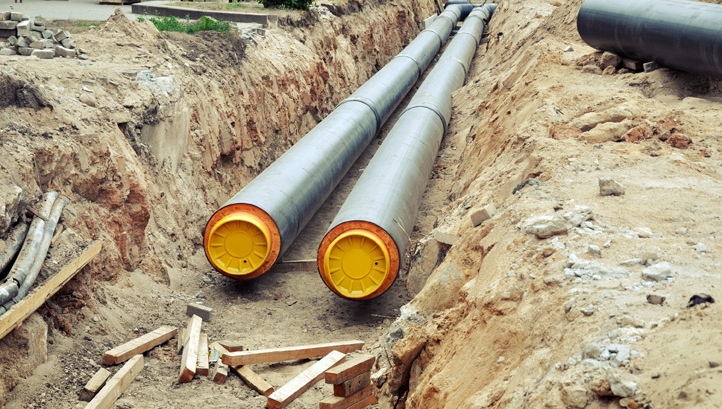In the immediacy of a global pandemic it’s sobering to reflect that it is climate change that remains the foremost challenge humanity faces and Thursday’s chastening Progress Report to Parliament published by the Committee on Climate Change is a timely reminder to all of us that the clock to 2050 continues to run down.

It recommends that ministers act with urgency and decisiveness in securing a green and resilient recovery following COVID-19 should be heard by all of us.
There’s plenty of evidence that the message is well understood by many. Commenting on social media, Andy Yuill of Natural Power observed that we should already be “decarbonising a city the size of Sheffield every 16 weeks” if we are to have a planet habitable for future generations.
Whatever can be done now, in 2020, to lower our carbon footprint should be done. It must be done.
Enter heat networks, which have the proven capability to transform the way we heat our homes and businesses, a process that currently accounts for over a third of our total greenhouse gas emission output. With a significant push from the government, which nurtures incentives for businesses, consumers and investors alike, all parties would be remiss not to interrogate this opportunity, especially in this period of economic hibernation brought on by COVID-19.
Heat Networks are the bit of the puzzle we can be working on now
Heat networks are networks of pipes (typically underground) that transfer heat from a centralised source – often heat that would have otherwise gone to waste – and deliver it to multiple buildings directly. The efficiencies heat networks offer are vital since they not only reduce gas consumption – but waste far less energy than the national grid. Developing them into a major part of our energy mix could be essential in the fight against climate change and an important component in upgrading our urban areas into smart cities of the future.
In order to kick-start the transition to heat networks from the more carbon-intensive national grid, the government has set aside £320m in grants and low-interest loans to be distributed via its Heat Network Investment Project (HNIP) to create the market conditions for businesses, local authorities and investors to come together to develop new or extended heat networks.
This is already being seen to effect, with newly constructed heat networks currently reducing UK carbon dioxide emissions by 700,000 tonnes per year, with around 500,000 customers using the technology, meaning savings of 3,000 GWh gas imports annually. Such promising figures provide a clear argument for what could be achieved with heat network’s further scaling and integration into the fabric of UK’s future economy.
Heat Networks aligning with the economy of the future
Once the economy begins to reopen, the energy outlook will look hugely different to that seen before the crisis. The rethink stemming from COVID-19 will accelerate the current trend of renewable energy beginning to take centre stage. Indeed, the renewables sector is set to be the only energy sector to see growth against such an unprecedented context. As natural gas and oil are set to decline – investment in renewables will inevitably rise.
And heat networks are well aligned with future green energy trends and could attract significant ESG investment, which is gathering momentum in the energy sector.
Currently, just 2% of buildings in the UK are running on energy from heat networks. The over-reliance on gas makes the heating sector one of the few in the energy industry that has not made large-scale changes to address climate change. Wider uptake of heat networks in this respect offers great potential for impact-conscious investors to increase exposure to the sector. Also encouraging is the measured uptake by established companies in the sector, promoting confidence in the sector’s future.
Lockdown has been a catalyst for heat networks, and the momentum must continue
The lifting of lockdown measures represents a vital call to action. Unsurprisingly, the lockdown has caused greenhouse gasses to decline globally as a result of reduced activity, and they have done so, with daily CO2 emissions in April falling 17% against the same time last year. But as we emerge from these restrictions, that figure is set to return to and even exceed pre-pandemic levels due to the increase in energy demand. It is paramount, therefore, that more of this demand for energy can be satiated through greener means to ensure we don’t emerge from one crisis just to continue directly into another in the shape of irreversible climate change.
Take, for example, May’s £25m HNIP Round 3 funding award which included a project utilising geothermal energy from former coal mines in Gateshead. Around 25% of UK homes and businesses are situated on former coal mines so the innovation has potential far beyond just Gateshead alone.
Carrying forward this momentum will help ensure a curbing of emissions, but it also has wider socioeconomic implications too. Local authorities have a mandate to encourage local economic growth and heat networks represent a tremendous opportunity to create high-value jobs in what the COVID crisis has made a hostile employment market. Expanding on the thinking of the Local Government Association, the Institute of Public Policy Research estimates that as many as 81,000 new jobs could be created in the district heating sector out of a total of almost 700,000 new jobs directly attributable to the transition to a net-zero economy.
Heat Networks provide an advantage for all parties
Companies who adopt these systems benefit too. Heat Networks, after being installed, are one of the most seamless ways a company can lower its carbon footprint in an environment where calls to do so by consumers are becoming ever louder. As well as the obvious environmental benefits to such a measure, there are also immediately tangible ones, too. Businesses benefit from avoiding the Climate Change Levy – a vital cost saver as we negotiate tighter budgets in a weakened, post COVID-19 economy. Additionally, given their effectiveness at transporting energy, heat networks once installed are less costly than ordinary gas arrangements. This means long term energy savings for companies on a corporate level, but on a societal level, it is a leap forward in addressing fuel poverty in the UK.
In February, this was exemplified by Peel Energy’s accepted plan to deliver the Liverpool Waters Heating Network, which will on completion supply cheaper, more efficient heating to 9,000 residential units and 315,000 m2 of business space in the historic Liverpool Docks area of Merseyside.
By Ken Hunnisett (Project Director, Triple Point Heat Networks Investment Management)
Originally published on



